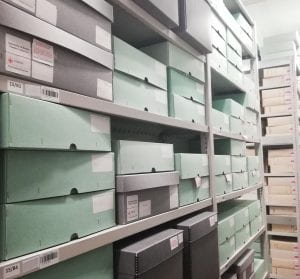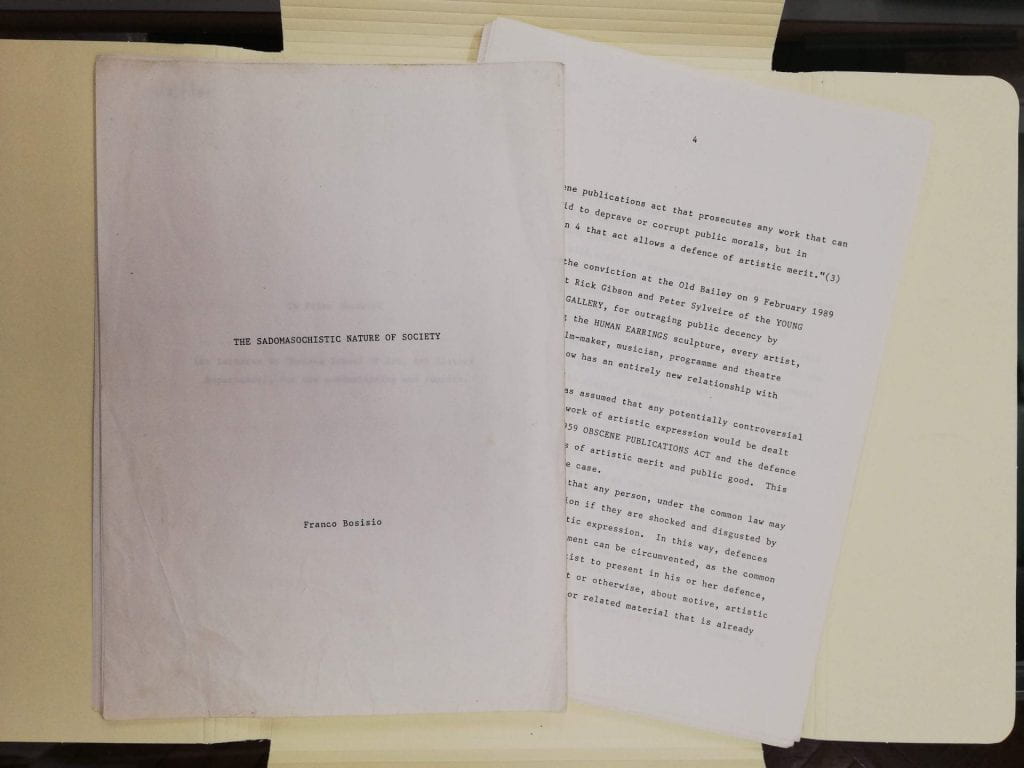As part of the Wellcome Trust funded project Challenging Archives: Delivering research access, public engagement and the curatorial care of the Franko B archive, writers-in-residence Mary Paterson and Maddy Costa are engaging creatively with the Franko B archive as it is catalogued, conserved and made accessible. Their blog posts reflect on the complex set of challenges the Franko B archive poses, the archival process and Franko B’s artistic practice, which explores issues such as the limits of the body and the human condition, dealing with pain, suffering, abuse of power, empathy, eroticism, and sexuality in contemporary culture.

by Maddy Costa
Although it might not look like it, this post is constructed from two interviews: with Stefan Dickers, Library and Archives Manager at Bishopsgate Institute in London, and Dr Justin Bengry, Lecturer in Queer History at Goldsmiths, University of London. I approached both of them with a vague set of thoughts about how an institution confers value: is there a qualitative difference between the “value” of Franko B’s work within the Theatre Collection and Tate’s archive, for instance? Certainly the art market and performance market are wildly different financial beasts. At a discussion event with Franko, attended by Alison Lister, the textile conservation specialist who has been working with his canvases, we talked about how the canvas held by Tate is sealed within a protective environment, whereas Alison sees the organic properties of the work, its propensity to degrade where stained, as integral to the experience of interacting with this archive. I’ll be thinking about this further in a future post.
My conversations with Stefan and Justin started with these questions but soon journeyed elsewhere, in directions focused less on abstract notions of value and more on the human aspects of the encounter within the archive. The texts that follow have been written by merging their voices with mine: I’m grateful to Stefan and Justin for their generosity both in sharing their time, thoughts and work with me, and in allowing me to render their words in this way.
Dear future student
Let’s imagine a consistency from my time to yours. That the doors to the library are still heavy and intimidating, that to reach the archive requires passing through a wood-panelled vestibule, dark and austere. I don’t remember any more what I went through to become comfortable in those spaces, it’s just you do it and do it and do it again. It might feel risky, as though something is at risk.
Perhaps you know what you’ve come here in search of. Perhaps you’re searching not knowing. I ended up doing queer history by accident: sifting through different materials, poring over images, slipping through the margins. Cultivate your queer Spidey sense. I want to propose this as a proper methodology: just flipping through things, something grabs your eye. There’s not a reason for it: something unconscious takes your eye there. This might be the springboard for a new line of research, for a lifetime of slowly unfolding work.
Some of what you see might surprise or unsettle you. What we’re doing here, the collecting of diverse sexuality and wider queer experience, is quite new territory. Think of the archivist as your companion and guide, translating from catalogue to object, text, or image. They might say informally: do prepare yourself. Prepare yourself with trust.
Notice the affective power in actually holding materials. There is something electric about that encounter with an object that has touched someone that you’re researching, that has been created by someone you’re researching. Your relationship with what you’re studying can change when you have a tactile experience of the remnants of what people have left behind. What has degraded over time, because of this touch? There is always existing damage, and damage that I’ve created. Harm is inevitable. Franko’s archive speaks to that harm.
What you are looking at is not just a spectacle: it is profoundly political. To know this you need the context. That context can be the context of the moment of creation and the politics behind it, it can be the context of the acquisition of the piece, it can be the context in which you’re now viewing it. It’s going to have multiple moments of historical significance. Lines of connection strung like a spider’s web, sticky and strong, across these contexts, past and present, my now and your now, imagined forward and back. That queer Spidey sense moving through and between, evaluating, reflecting back on the period, and seeing what that means to us. Whisper back to me what you see.
Dear future historian
[of art? performance? aesthetics? spaces of gathering? galleries, or nightclubs, or community halls? of queer lives? subcultures? social foment? resistance?]
Let’s imagine a progression from my time to yours. That the opening of the archive to the social and cultural experience of queer Britain has been one among a series of profound and positive shifts in understanding human relations, that heterocentricity has shifted off centre, that heteronormativity no longer claims normality. These archives stand as reminders that the routes to those changes were complex and multifaceted; that queer history is not just about being annoyed and pissed off, about protest, campaigning, going on pride marches. The expression of the queer community is not just making a placard: it’s about singing clubs, dancing clubs, poetry, writing a play. And it’s about sexuality, about kink and fetish, the leather rubber scene – desires, experiences and expressions of self whose meaning and value are changed by being deemed by experts to be worthy of interrogation, investigation, examination.
What might be required to think yourself back, to the rancour and violence of my time? Might the blood shed on a sheet of canvas do it? An image of a man bound in hospital paraphernalia, shaking a nightclub crowd out of its complacent hedonism? Has the violence of language been tempered? What words need excavating for the difference between your now and mine to burn clear? Classification – how people have been named and identified in the past – is really interesting. We deal with this a lot in LGBTQ histories. What do we do with keywording that either leaves us out entirely, or uses words and terms that lose meaning or gain different meanings or become offensive? Faced with offensive labels and cataloguing information, do you say, ‘we are a progressive institution and we don’t want to project that offensive material on to our staff and patrons’? Or do we say, ‘our catalogue itself is a historical document’? I lean towards the latter. It’s important not to lose that information, because if you don’t know that it had been catalogued like that, it’s easier to imagine that the archive was always this beautiful, welcoming, inclusive place, and it wasn’t.
Franko’s archive winds through progressive waves of homophobia, progressive acts of humiliation against humans who don’t conform to gender or sexual stereotypes, progressive attempts to marginalise anyone who lives differently. The work of classifying and cataloguing addresses the past from the present. I hope you recognise that past as a distant landscape, narrowing your eyes in relief.
Dear future archivist
Let’s imagine a collapse of civilisation, or environment, or both, between my time and yours. What has been saved? Has Franko’s work been saved? While everything around it has crumbled has the archive somehow managed to settle, like geological layers compressed in time? I’m going to trust that the answer is yes. That the archive was deemed precious, worth saving. And that happened because of how archivists now and in the future steer people here.
This is the work of the archivist, this guidance. I’ve always seen working in an archive as similar to working in Boots. It’s a service industry. You’re not a guardian, you’re not a custodian: you’re a facilitator. Someone comes in and says, I want to see something or I want to know more about this, and your job is to facilitate that person to go away having learned more about that. And that’s a political thing, because you decide what to show them and what routes to take them down – and I would try to open up all options.
You hold a position of power framed by generosity. You hold a position of vibrant authority. I’m so reliant on archivists who know their collections better than I ever will, to say – once I’ve explained what I’m researching – oh, have you thought about this collection, when nothing in the catalogue suggests to me that I would have looked there. They know better than I do where I might find things, especially if they’ve been there for a long time, if they accessioned it, and might have been the ones cataloguing it. When an archivist moves on, institutional knowledge is lost. The loss of the knowledge that was there can feel like it deadens an archive. You understand this so well: that an archive is a living collection, but it’s even more living when a living, breathing human is there to open it up to you. And further: there’s no way you can get the physical experience of using an archive from a catalogue. Knowledge passes palm to palm.
You recognise how this job is laced with political decisions, especially when the archive in question involves bodies, queer bodies, leaking bodies, bodies abraded, pierced, scarred. Some might dismiss the images you hold as obscene, but again, what’s obscene is completely political – and who am I to make those kinds of decisions? What you choose to protect is political. So is the question of who. And of course that influences the stories we can tell. How you begin those stories – with the language you choose to wrap around the catalogue – is political. With society in tatters, these stories might reform/re-form society’s foundations. Every piece of the archive a stone to build on.
Dear future artist
Let’s imagine, you and me. Isn’t that the invitation? Immersed in this disrespectable archive, with its tattoos and its scrawls and its weight of canvas drill, with its boots and its radiation mask and its unrepentant images. Image imagine imagination. Deep in the roots of the word imagine an old French word meaning sculpt, carve, paint, decorate, embellish. I think of your hands, moving through Franko’s archive, how open it is to your touch. What do you make of it? What might you make from it? I reach out from the past to discover.

